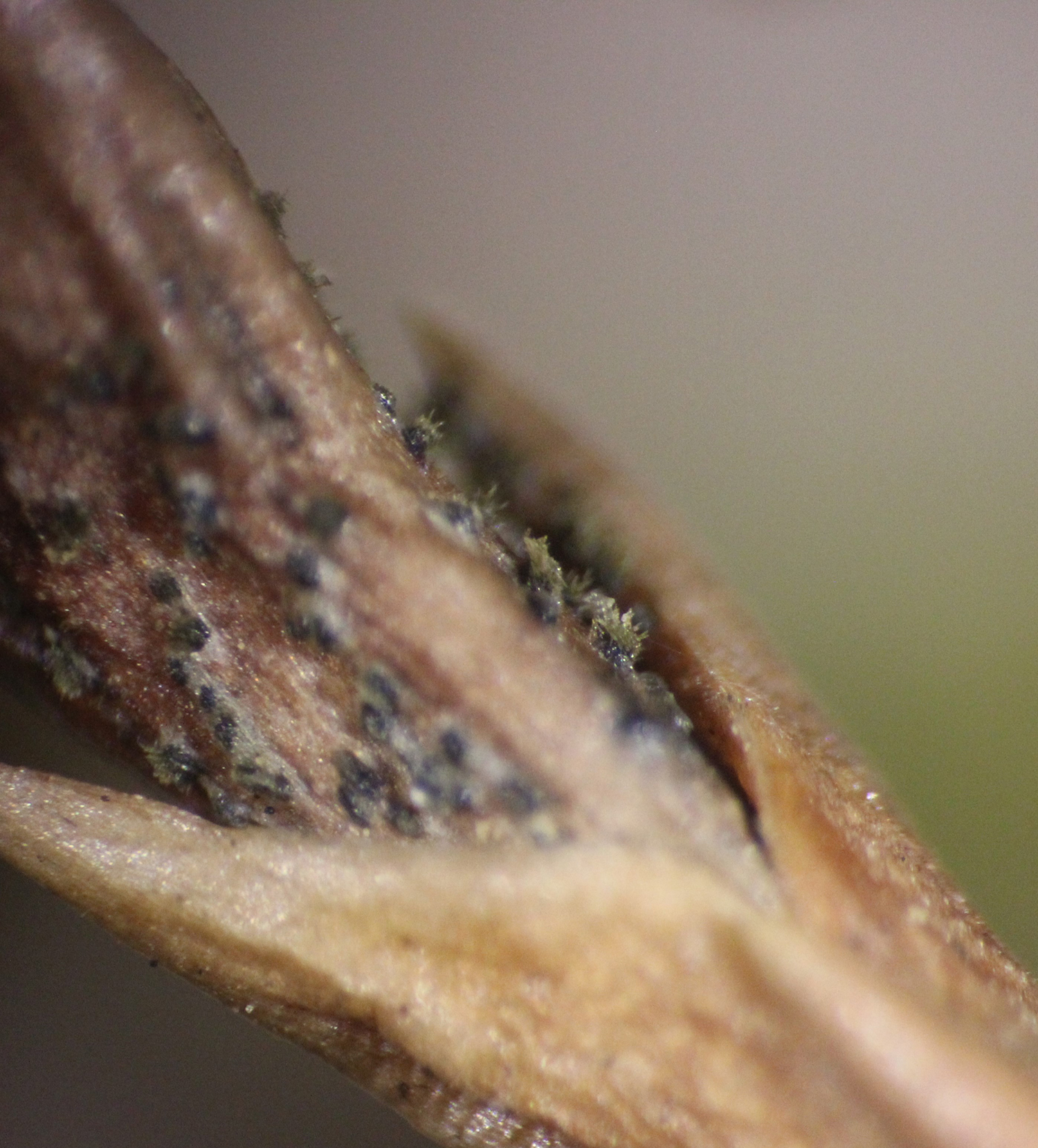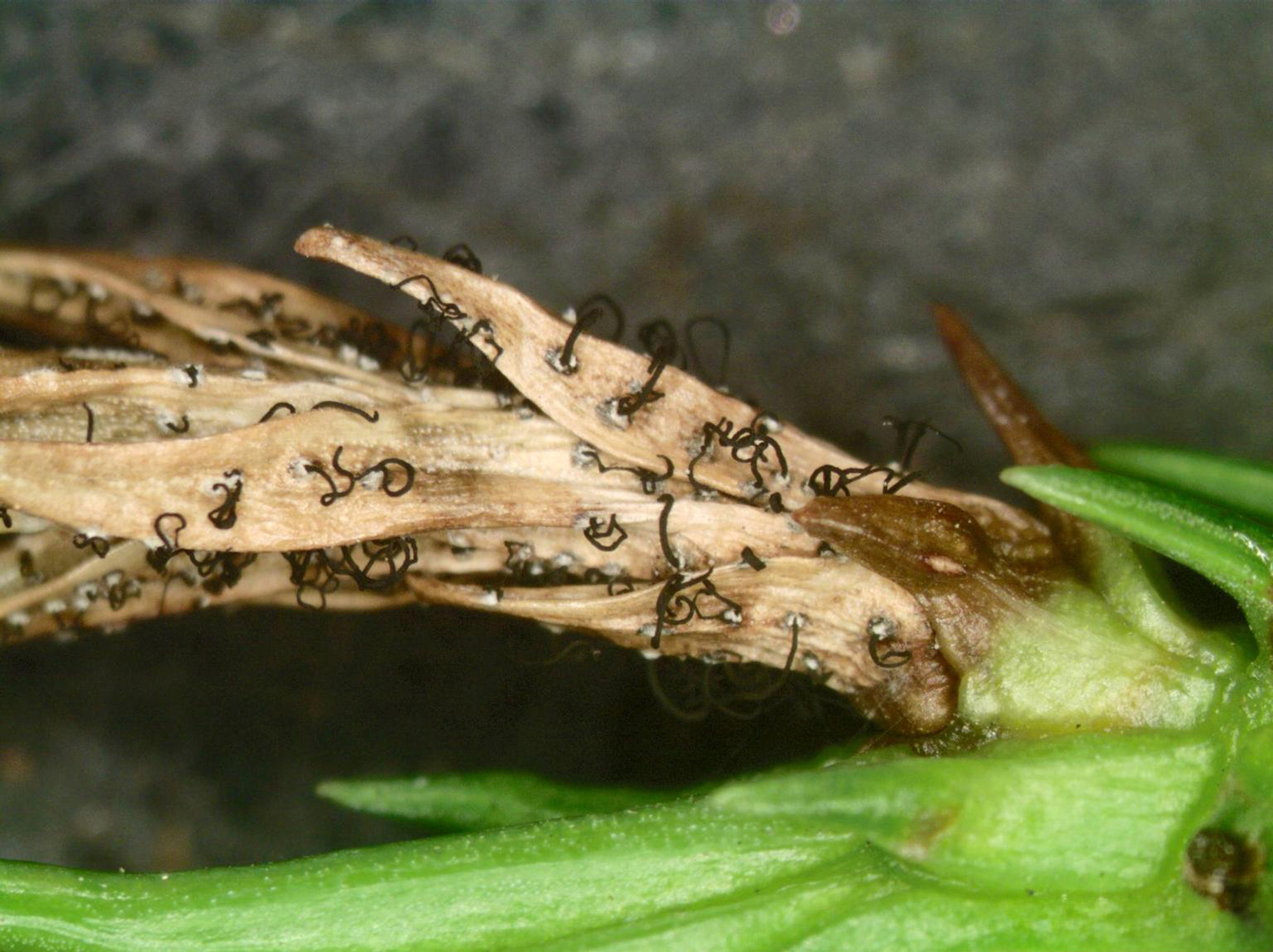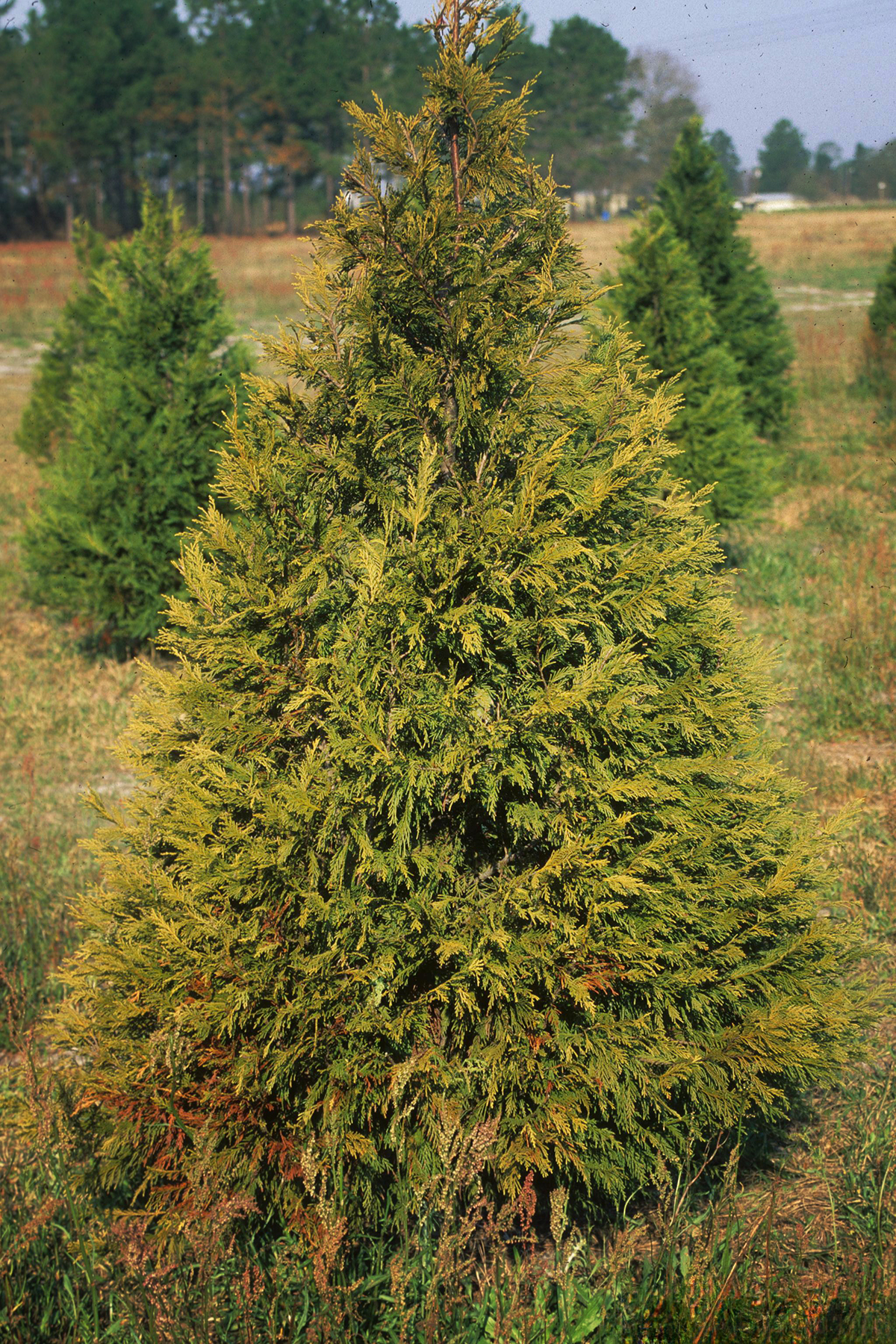Diseases and Disorders of Leyland Cypress
Leyland cypress (× Hesperotropsis leylandii) is a feathery-leaved evergreen with a reputation for rapid growth and hardiness that has made it a popular choice for Christmas trees, privacy hedges, and windbreaks. Unfortunately, many of these uses involve close plant spacing, which, when coupled with the climate and site conditions common to Mississippi, can reduce the vigor of Leylands and make them more susceptible to certain problems. This publication covers the most common diseases and disorders impacting Leylands in Mississippi.
Leylands require well-drained soil and do not tolerate low-lying sites, heavy clay soils, or poor drainage. Trees on sites with poor drainage often have severe twig dieback problems, whether they are open-grown or in hedges, and root disease also can be a problem.
Deformed roots are another common cause of tree failure in Mississippi. Before planting, carefully examine the root systems of potted Leylands to ensure they are not pot-bound. Pot-bound Leylands are more susceptible to winter foliage burn and diseases and will eventually die.
Needle and Twig Dieback
Needle blights are characterized by rapid needle browning, which often leads to dieback of twigs and branches. In Mississippi, three fungi are responsible for most Leyland needle blight diseases.
Leaf wetness and high humidity favor leaf infection. Air circulation is often poor in hedge and Christmas tree plantings, providing a highly humid environment that is ideal for fungal infection. The presence of small black fruiting structures can help differentiate needle blight diseases from similar damage caused by other factors.
Cercospora Needle Blight (Passalora sequioiae)
Symptoms of Cercospora needle blight usually begin in the lower part of the tree canopy and move from the interior of the plant toward the branch tips. As infected needles age, they may turn from brown to gray. Tiny, black fruiting structures may be visible on brown or gray needles. The fruiting structures may appear fuzzy and dark olive-brown if they are producing lots of spores (Figure 1). A magnifying lens is helpful for observing this feature.

The fungus produces spores from spring through fall. The most favorable conditions for infection occur when temperatures are around 68°F and humidity is high. Symptoms usually appear about three weeks after infection. The fungus overwinters in infected needles.
Management strategies rely heavily on good cultural practices as well as fungicides.
Pestalotiopsis Needle Blight (Pestalotiopsis spp.)
Symptoms of discoloration often begin in the lower part of the tree. Needles begin to brown at the tips and the discoloration moves toward the base of the needle. Often branch tips are affected first and the symptoms move down the branch toward the trunk. During wet conditions, long, black spore tendrils will ooze from the small, black fruiting structures on the needles (Figure 2).

The Pestalotiopsis fungus is a normal part of the microbial community on needles of Leyland cypress and only causes disease when the plant is injured or stressed. Spores infect through natural openings, wounds, or damaged tissue. The fungus can survive on living and dead plant material as well as in soil and on contaminated tools. Spores will spread on air currents and in splashing water.
Management strategies rely on good cultural practices. Fungicides are not typically used to manage this disease in the landscape.
Arborvitae Needle Blight (Phylosticta thujae)
Arborvitae needle blight is less common on Leyland cypress in Mississippi, but it does occur. Symptoms are very similar to the other needle blight diseases, with discoloration beginning at the needle tip and moving down. The black fruiting structures look very similar to the other needle blight fungi, but they will not be fuzzy or have long, black spore tendrils oozing from them. If they are wet, cream-colored spores may ooze out of a round pore in the center of the fruiting structure.
The fungus appears to infect only stressed or injured trees, such as those that have experienced winter burn (desiccation) or heavy pruning. Spores are released during wet weather and are moved to nearby needles by splashing water or wind.
Needle Blight Management
Wide Plant Spacing
Leyland cypress grows quickly, so take tree growth into consideration during landscape design, or when planting Christmas trees or laying out nursery blocks. Wide plant spacing promotes air circulation and reduces the humid conditions in the tree canopy that favor infection by needle blight fungi.
Thinning
Removing every other tree from crowded plantings can improve air circulation and reduce humidity within the planting.
Pruning and Sanitation
Remove and destroy dead or severely damaged branches. Pruning or shearing trees when they are wet can spread needle blight quickly, so it is important to conduct these activities when the trees are dry. Disinfect pruning tools frequently—at least between each tree. See Extension Publication IS1955 Choosing a Disinfectant for Tools and Surfaces in Horticultural Operations for more information on keeping tools clean.
Water Management
Extremes in soil moisture are stressful to trees and increase susceptibility to disease. Plant trees on well-drained sites and avoid overwatering. Trees planted on slopes or sandy soils that drain well may benefit from irrigation. A soaker hose or drip irrigation system provides adequate water without wetting the leaves.
Fungicides
Chemical control can prevent or reduce new infections but will not cure active infections. When disease pressure is high due to weather or cultural conditions, the effectiveness of chemical treatment is significantly reduced.
Fungicides containing active ingredients such as mancozeb, copper, myclobutanil, and azoxystrobin are labeled for prevention and control of Cercospora needle blight and may provide some protection against other needle blight fungi.
Products easily accessible by homeowners for do-it-yourself applications include Southern Ag M-45 and Monterey Liqui-Cop. Products that can be applied to both landscape and commercial production settings include, but are not limited to, Dithane M-45, Eagle, Heritage, and Kocide 2000-O. Products labeled exclusively for Christmas tree production include Kocide 2000 or Kocide 3000.
Canker Diseases
A canker is an area on the branch or trunk where the vessels in the wood that transport water and nutrients (xylem and phloem) have been killed. Everything above the canker turns brown and dies from lack of water. Cankered areas are usually slightly sunken because the xylem and phloem cells have collapsed. Fruiting bodies of the fungus may be visible as tiny, black pimples on the bark covering cankered wood. Wetting the canker and using a magnifying lens can make it easier to see these structures. Wood beneath the bark of a canker is brown.
Fungi that cause canker diseases of Leyland cypress are opportunists, meaning that they cause disease on weak or stressed trees but not on vigorous trees. Root dysfunction from physical deformity or moisture extremes are the two primary factors in Mississippi that make Leylands vulnerable to canker diseases.
Cypress Canker (Seiridium unicorne)
Cankers caused by Seiridium appear on twigs, branches, and the trunk (Figure 3). Cankers are oval-shaped (longer than they are wide), and the tree bark often appears dark brown to purple. Small, black, pimple-like fruiting structures of the fungus may cover the canker surface. Spores ooze from these fruiting structures when the bark is wet and spread in splashing water and on contaminated pruning tools.
Cypress cankers often ooze resin (tree sap), which can make fruiting structures difficult to see. Resin flow is less pronounced on older trees or trees in poor vigor. Keep in mind that healthy Leylands can leak resin through any opening in the bark, especially during wet springs, so the presence of resin does not always mean cypress canker is present. If the wood beneath the bark is brown in the area that is oozing sap, then cypress canker is likely present. Needles on affected branches transition from green to yellow-orange to brown as they die. Discoloration of needles is a typical symptom of water stress and by itself does not indicate cypress canker.
Infection occurs when trees are wet. Spores infect through natural openings or wounds in the bark, or through leaves and shoots. Spores are produced all year and spread by splashing water and insects. They can survive several weeks without water. Trees that are stressed by drought or excessive soil moisture are more susceptible to infection.
Cypress Canker Management
Leyland cypress is very susceptible to cypress canker, and environmental and site conditions in Mississippi are generally stressful for the tree, which increases susceptibility to infection.
Plant less susceptible trees such as Arizona cypress (Cupressus arizonica), arborvitae (Thuja spp.), and Japanese cedar (Cryptomeria japonica).
Remove and destroy diseased branches by making pruning cuts several inches below the edge of the canker. Avoid pruning trees when they are wet, and disinfect pruning tools between each cut by wiping them off with 70 percent isopropyl alcohol.
Maintain vigorous trees by planting at the proper depth in soil that is moist and well drained. Space trees adequately to avoid stress from overcrowding as trees grow. Plant Leylands in protected areas to prevent winter burn (desiccation).
Chemical control is not available.
Botryosphaeria Canker (Botryosphaeria dothidea)
Cankers are generally long and oval-shaped. The canker surface often looks flat, and the bark is usually a reddish-brown color with black, pimple-like structures visible on the surface. Resin flow is not typically associated with Botryosphaeria canker.
The fungus is usually associated with the tree but does not cause disease until the tree becomes stressed. Abiotic stresses such as drought, frost, physical injury, and waterlogged soils are the most common triggers.
Botryosphaeria Canker Management
Remove and destroy diseased branches by making pruning cuts several inches below the edge of the canker. Avoid pruning trees when they are wet, and disinfect pruning tools between each cut by wiping them off with 70 percent isopropyl alcohol.
Maintain vigorous trees by planting at the proper depth in soil that is moist and well drained. Space trees adequately to avoid stress from overcrowding as trees grow. Plant Leylands in protected areas to prevent winter burn (desiccation).
Chemical control is not available.
Root Rot (Phytophthora spp.)
Phytophthora root rot is a disease of trees growing in soils that remain saturated for long periods. Because the roots are destroyed by the pathogen, the tree shows symptoms that resemble drought stress. Needles fade to yellow and then turn brown (Figure 4). The tree may show signs of wilt, and growth will be slow. Examination of the root system will reveal fewer than normal roots, and the roots will be dark brown or black on the inside.

Phytophthora is a fungus-like organism that survives in water, soil, and infected roots. In saturated soils, Phytophthora produces zoospores that can swim through the film of water surrounding soil particles and infect the growing tips of fine feeder roots or infect wounds in roots.
Phytophthora Root Rot Management
Site Selection and Water Management
Plant Leyland cypress on well-drained sites. Avoid planting on heavy clay, in low lying areas, or in drainage paths. On poor sites, plant in raised beds. For plants that have already been installed on poor sites, install French drains or divert drainage away from the planting.
Soilborne pathogens are notoriously difficult to control and nearly impossible to eradicate. Phytophthora produces structures that enable it to survive for years in the soil. Avoid replanting Leyland cypress in areas where trees have died from Phytophthora root rot.
Phytophthora infected trees will probably die. Mildly affected trees may survive if water stress is eliminated and fungicides are properly applied.
Fungicides
Chemical control can reduce or prevent new infections and may slow active infections, but it is unlikely to completely eradicate Phytophthora from the plant or the soil. Apply fungicides as a soil drench at the rate and frequency described on the product label.
Products that can be applied in both landscape and commercial production settings include Subdue Maxx and Aliette.
Abiotic Disorders
Winter Burn (Needle Desiccation)
Water loss through natural openings in leaves is a normal physiological process for plants. For evergreens, this water loss continues throughout winter. Needle desiccation (drying) occurs when the plant cannot absorb enough water through its roots to compensate for what is being lost through the leaves. Trees growing in exposed, sunny, or windy locations are particularly vulnerable in winter, as are trees that are drought stressed in the fall.
Leaves with winter burn appear orange to bronze or brown (Figure 5). Mildly affected plants will green up in the spring. Any branches that do not green up in the spring can be pruned out. Prevent winter burn by making sure trees receive adequate water before winter dormancy. Erecting a temporary winter windbreak for trees that are in exposed locations also may reduce damage.
Root-Bound (Pot-Bound)
The condition of being root-bound, sometimes referred to as pot-bound, occurs when roots grow in a circular pattern or in a J-shape. Such growth patterns occur when the roots encounter an impenetrable substrate, like the side or bottom of a pot. This can happen at the nursery or retail outlet if plants are not re-potted into larger containers before the root system outgrows the pot it is in. In the landscape, tree roots may encounter an impenetrable substrate, such as concrete or severely compacted soil. As the roots increase in size, they continue their circular or J-shaped growth pattern, which inhibits the flow of water and nutrients between the roots and branches.
Symptoms of root-bound plants are typical of any root stress problem. The crown of the plant thins. Leaves may be slow to come out in the spring or be stunted or may brown or wilt as if drought-stressed. Circling roots may be visible near the soil surface, but it is usually necessary to excavate the root system to examine the structure of the root ball. Once aboveground symptoms are visible, the damage is irreversible, and the tree cannot be saved.
Prevention is the only way to manage root-bound plants. Examine the root ball before installing potted trees in the landscape. If the roots are slightly pot-bound, straighten them before placing the tree in the planting hole. If the roots cannot be straightened, discard the plant or return it to the producer.
Do not twist the plant into the planting hole. Plant trees quickly after purchasing them, and be extra vigilant when transplanting large trees from pot to landscape. Beware of “bargain” trees in containers that may have been on the retailer’s lot for a long time because they are more likely to be root-bound.
Note: Chemical labels change; always get current information about usage, and examine a current label before applying any chemical. Always follow label directions when applying chemicals.
The information given here is for educational purposes only. References to commercial products, trade names, or suppliers are made with the understanding that no endorsement is implied and that no discrimination against other products or suppliers is intended.
Publication 3621 (POD-04-24)
By Clarissa Balbalian, Diagnostic Laboratory Manager, Plant Pathology.
The Mississippi State University Extension Service is working to ensure all web content is accessible to all users. If you need assistance accessing any of our content, please email the webteam or call 662-325-2262.





